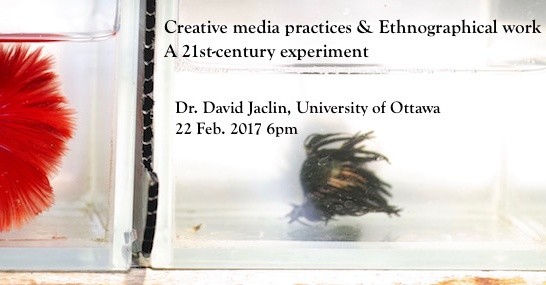Creative Media Practices & Ethnographical Work. A 21st-Century Experiment.
Seminar
22 Feb 2017
06:00pm
M6058 (Level 6) Run Run Shaw Creative Media Centre, 18 Tat Hong Avenue, Kowloon Tong
|

|
Data matters for science (where measuring is key), for politics (where convincing is key) as well as for the social sciences (where representing is key) and the arts (where estranging is key). As for Anthropology, the discipline has been thinking of data for almost 150 years, problematizing in its own ways the difference between maps and territories, between operating on something (measuring it, convincing it, representing it or estranging it) and the thing in question.
At a time where digital arts are building (producing and elaborating on) a enormous amount of data, the question becomes not only epistemological (what is a data?) or methodological (how is a data produce?) but also an affective one (what does a data can actually do, and to who exactly?).
In fact, a data can both objectify and subjectify at the same time. It can turn a living organism (such as an animal, a plant or a virus) into statistics, infographics, economics, but data can also animate pixels and turn them into a genetically modified crop, an anime machine or a viral software (I will talk briefly about de-extinction enterprises and the so-called resurrection of the woolly mammoth to illustrate this point...).
As we enter in the 21st century and while the amount of data produced daily has no comparison in history, I would like to share some reflexions about ethnography (ethnos + graphein or, the depiction of a multitude) and media (a growth milieu with and within which things propagate).
In my work, where I am interested in international wildlife trafficking, I ended up experimenting with new media apparatuses in order to develop another approach to deal with living organisms being poached, for instance.
To capture or not capture, this is my question.
Dr. David Jaclin
Assistant professor at UOttawa’s School of Sociological and Anthropological Studies.
Head the HumAnimaLab.
At the intersection of Animal Studies, Anthropology and Communication Studies, my research draws on informational and communicational processes (genetic, epigenetic, behavioral and symbolic) involved in human-animal relationships, with a particular focus on their cultural implications as well as on their evolutionary dimensions. Building on multi-sited, multi-species and multi-medias ethnographies, my work investigates some of our contemporary modes of interaction with animals.
Such modes are here approached in a media ecology perspective, where a living organism, like any medium, is not simply apprehended as a passive vehicle for a message but rather envisioned as a transductive milieu.
I am currently working on the international trafficking of exotic animals and the green criminality fuelled by this black market (i.e. its commercial, cultural and affective routes, its ecological impacts and the biopolitical stakes involved in conservation in particular).
Enquiries
Dr. Damien Charrieras dcharrie@cityu.edu.hk